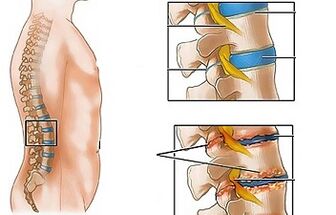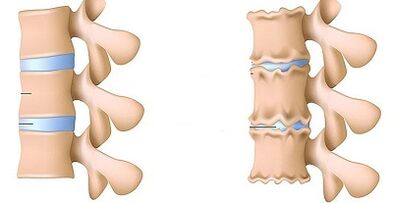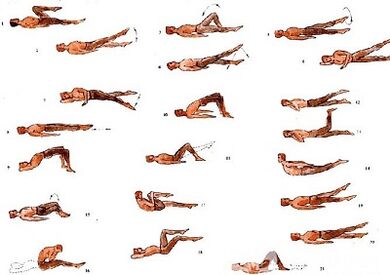
Lumbar osteochondrosis is a chronic disease that develops as a result of a degenerative-dystrophic process in intervertebral discs.The disease is widespread and in most cases affects people from 25 to 40 years old.
According to the statistics of back pain, at least once in his life experiences every other adult, while in 95% of cases they are caused by osteocondrosis in the spine.
Patients with a severe course of lumbar -skin terocondrosis with persistent pain and other manifestations are recognized as temporarily disabled.If their condition is not improved within four months, the issue of establishing a disability group is resolved.
Lumbar osteochondrosis is a serious medical and social problem as the disease mainly affects people of the most working age, and in the absence of treatment it can cause the formation of hernia of the intervertebral disk.
Causes and risk factors
The factors that dispose of the development of lumbar -skintochondrosis are:
- Abnormalities of the spine;
- Lumbarization is a congenital pathology of the spine, characterized by the separation from the sacrum of the first vertebra and its transformation in the sixth (further) lumbar;
- Sacralization is an innate pathology in which the fifth lumbar vertebra is fed with the sacrum;
- the asymmetrical location of the articular cracks in the intervertebral joints;
- pathological narrowing of the spinal cord;
- reflected spondiogenic pain (somatic and muscle);
- obesity;
- sedentary lifestyle;
- prolonged exposure to vibrations;
- Systematic physical load;
- Smoking.
Side effects with negative statodynamic load combined with one or more risk factors lead to a change in the physiological properties of the jacket core of a fibrous disk that plays a shock -returning role and provides the mobility of the spine.The basis of this process is the depolymerization of polysaccharides, leading to loss of moisture with a substance of the jet core.As a result, the jacket seeds and with the fibrous disk lose their elastic properties.Additional mechanical loads provose the protrusion of the fibrous ring that has lost elasticity.This phenomenon is called protrusion.Cracks appear in the fibrous core through which fragments of the jacket core (prolapse, hernia of the intervertebral disk) fall out.
A long compression of the nerve roots that indulge in certain organs of the abdominal cavity over time leads to a deterioration of their function.
The instability of the spinal cord segment is accompanied by reactive changes in the bodies of adjacent vertebrae, intervertebral joints and at the same time spondy arthritis develops.Significant muscle contraction, for example, on the basis of physical activity, leads to a shift in the spines and violation of nerve roots with the development of radicular syndrome.
Osteophytes can be another cause of pain and neurological symptoms with lumbar -skin terocondrosis - bone growth of processes and bodies of vertebrae that cause roys hold -syndrome or compression myelopathy (spinal cord compression).
Forms of the disease
Depending on the structures that are drawn into the pathological process, the lumbar osteochondrosis clinically manifested by the following syndromes:
- Reflex- Lumbalgia, Lumboichalia, Lumbago;Develop on the basis of reflective overwatching the muscles on the back;
- Compression (spinal cord, vascular, radicular)- Their development leads to compression (compression) of the spinal cord, blood vessels or nerve roots.Examples are lumbosacral radiculitis, radiculoichemia.
Symptoms of lumbar skeletrosis
With lumbar -skin -skintochondrosis, symptoms are determined by which structures are drawn into the pathological process.
Lumbago occurs under the influence of hypothermia or physical overvoltage and sometimes without any obvious reason.The pain appears suddenly and shoots.It intensifies when sneezes, coughs, body turns, physical exertion, seat, standing, walking.In the supine position, pain is significantly impaired.Sensitivity and reflexes are preserved, the amount of movements in the lumbar area is reduced.
By palpation they observe:
- tenderness in the lumbar area;
- Spasm of paravertebral muscles;
- Flaving of lumbar lordosis, which in many cases is combined with scoliosis.
The tension syndrome of nerve roots with the lumbar is negative.When raising a straight leg, patients notice the rise in pain in the crucifix and not their appearance in an elongated lower extremity.
Often, with lumbar skin, there is often a repeated occurrence of pain attack, which each time becomes increasingly intense and long.
With Lumbalia, however, the clinical image resembles a lumbago, but there is an increase in the intensity of pain within a few days.
In the lumbar -shaped, patients complain of pain in the crucifixion, which radiates to one or both lower extremity.The pain spreads over the buttocks and back of the thigh and never reaches the feet.
Vasomotor disorders are characteristic of lumbar -shaking:
- changes in the temperature and color of the skin of the lower extremities;
- feeling of warmth or coolness;
- Violation of the blood supply.
The development of lumbar compression syndromes is manifested clinically by the following symptoms:
- dermatomic gipalgesia;
- shooting pain;
- impairment or complete loss of deep reflexes;
- Peripheral palsy.
With compression syndromes, pain intensifies when tilting the body, sneezing and coughing.
Diagnostics
Diagnosis of lumbar osteocondrosis is performed on the basis of the clinical image of the disease, laboratory and instrumental research methods.
In blood tests based on lumbar osteochondrosis it can be noted:
- decrease in calcium concentration;
- increase in ESR;
- Increase the level of alkaline phosphatase.
In the diagnosis of lumbar osteochondrosis, the radiological examination of the spine is of great importance.
A long compression of the nerve roots that indulge in certain organs of the abdominal cavity over time leads to a deterioration of their function.
X -Ray -Functions confirming the diagnosis is:
- change in configuration of the affected segment;
- Pseudospondylastez (displacement of related spine organs);
- Deformation of closure plates;
- Flaving of the intervertebral disk;
- The odd height of the intervertebral disc (symptom of the spacer) associated with the asymmetrical muscle tone.

Also in the diagnosis of lumbar osteochondrosis in the presence of indications:
- Myelography, calculated or magnetic rejection tomography - is necessary for persistent symptoms, the development of neurological deficiency;
- Scintigraphy (the study of accumulation of a bone system of phosphorus, a molten technology-99)-is performed in the event of suspected a tumor or infectious process, a spinal cord injury.
Differential diagnosis of lumbar osteochondrosis is performed with the following diseases:
- Spondylolistz;
- Disgormonal spondylopathy;
- ankylosing spondylitis (ankylosing spondylitis);
- Infectious processes (disk inflammation, osteomyelitis of the spine);
- Non -Plastic processes (primary tumor in the spine or its metastatic lesions);
- rheumatoid arthritis;
- deforming osteoarthrosis of the hip joint;
- Reflected pain (diseases of the internal organs and large blood vessels).
Treatment of lumbar -osteochondrosis
With lumbar vertebrae, they usually adhere to the following treatment tactics:
- bed rest for 2-3 days;
- traction of the affected segment of the spine;
- Strengthening the muscles on the back and abdominal press (the creation of the so -called muscle cross);
- Impact on pathological myofascial and myotonic processes.
Lumbago occurs under the influence of hypothermia or physical overvoltage and sometimes without any obvious reason.
In most cases, conservative treatment of lumbar ostocondrosis is performed, including the following goals:
- Muscle infiltration with a solution of local anesthesia;
- To take not -steroid anti -inflammatory drugs;
- Receiving Desensibilizing Agents;
- Vitamin Interapy;
- Receiving sedative and antidepressants;
- Manual therapy, massage;
- Physiotherapy Physical Education;
- acupuncture;
- Postisometric relaxation.
Absolute indications of the surgical treatment of lumbar osteochondrosis are:
- Acute or subacute compression of the spinal cord;
- The development of the horse syndrome, characterized by reduced function of pelvic organs, sensitive and motor disorders.
Medical Gymnastics for Lumbar Hudtochondrosis

In the complex treatment of lumbar -skin terocondrosis, a significant role in physical therapy exercises is included.Regular classes make it possible to normalize the muscle tone of the paravertebral muscles, improve metabolic processes in the tissues affected by the pathological process, and in addition to forming a well -developed muscle cross, which can maintain the spine in the correct position, remove excess static loads from it.
In order to gymnastics with loin osteocondrosis to bring the greatest effect to comply with the following principles:
- Regularity of classes;
- gradual increase in the intensity of physical exertion;
- Avoid overtime during the lesson.
Physical education should be engaged in the management of an experienced instructor who chooses the most effective exercises for a particular patient and controls the correctness of their implementation.
According to the statistics of back pain, at least once in his life experiences every other adult, while in 95% of cases they are caused by osteocondrosis in the spine.
In addition to classes with an instructor, you have to perform a complex of morning gymnastics daily that includes special exercises with lumbar -skin tutos.
- Relaxation and contractions of the abdominal muscles.The starting position stands, the legs are shoulder -width apart, the hands of the body are lowered.Make a smooth breath and relax the muscles of the anterior abdominal wall.During exhalation, draw yourself as much as possible and strain the muscles of the press.The exercise should be repeated before the appearance of slight fatigue.
- Movement of the head with bending of the spine.The starting position of the knee, which rests on the floor out of the back, is the back straight.Slowly lift your head and bent at the back.To get stuck in this position for a few seconds and then smoothly return to its original position.Repeat at least 10-12 times.
- "Pendulum".The starting position lying on the back, the arms along the body, the legs are bent at the right angles of the knee and the hip joints.Turn the legs to the right and to the left with swinging pendant -shaped movements and try to get the floor.At the same time, the shoulder blades cannot be torn off the floor.
- "Boat".The starting position of lying on the stomach, the hands are expanded forward.Tear the upper body and legs from the floor, bend in the back.To dwell in this position for 5-6 seconds and slowly return to the starting position.Perform 10 times.
Possible consequences and complications
The main complications of lumbar osteochondrosis are:
- the formation of intervertebral hernia;
- Vegetovascular dystonia;
- Spondylolis, spondylolistz;
- osteophytosis;
- SpondyLarthrosis;
- Stenosis in the spinal cord duct, leading to the compression of the spinal cord and able to cause persistent loss of work capacity and reduce the quality of life.
A long compression of the nerve roots that indulge in certain organs of the abdominal cavity over time leads to a deterioration of their function.As a result, patients have bowel dysfunctions (constipation, diarrhea, flatulence) and pelvic organs (urination, erectile dysfunction, frigidity, infertility).
Forecast
Pain syndrome for lumbar skeletos continues in the form of remissions and worsening.Lumbago lasts 10-15 days, after which the patient's condition improves, the pain decreases.Aparticular secondary diseases can interfere with a favorable result.Often, with lumbar skin, there is often a repeated occurrence of pain attack, which each time becomes increasingly intense and long.
In the complex treatment of lumbar -skin terocondrosis, a significant role in physical therapy exercises is included.
Patients with a severe course of lumbar -skin terocondrosis with persistent pain and other manifestations are recognized as temporarily disabled.If their condition is not improved within four months, the issue of establishing a disability group is resolved.
Prevention
Prevention of the development of osteocondrosis of the spine is the following target:
- Refusal of smoking;
- Normalization of body weight;
- Improving general physical condition, active lifestyle;
- Avoid provoking conditions (weightlifting, sharp movements, turns, inclinations).


















































